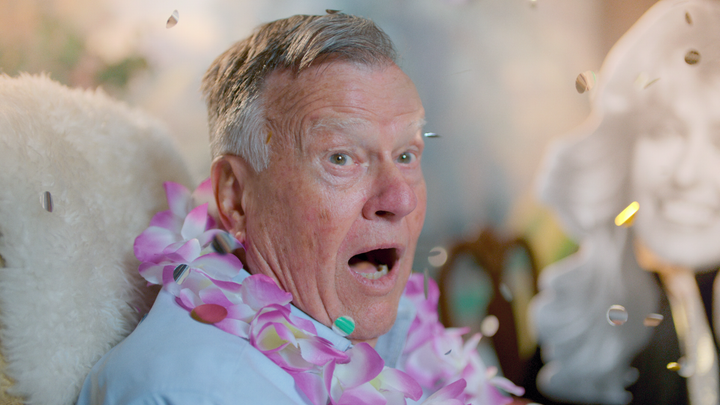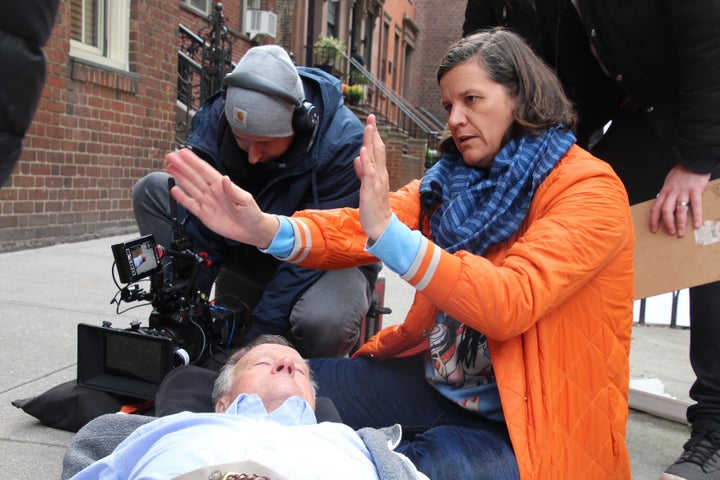
In “Dick Johnson Is Dead,” Dick Johnson isn’t really dead. Certainly not in a material sense. The title of this nourishing documentary, now available on Netflix, hints at the film’s many meta gags. Dick is director Kirsten Johnson’s octogenarian father, a Seattle psychiatrist with an enviable joie de vivre. One look at his trusting smile and you’ll hope he never leaves this earth. Early on, we see him strolling down a sidewalk when a falling air conditioner pins him to the ground. It’s the first fake death Dick will suffer at the hands of his daughter, who sought to process his dementia diagnosis by firing up her camera and staging outlandish scenarios that force the two of them to confront Dick’s mortality.
“Just the idea that I might ever lose this man is too much to bear,” Johnson says in a voice-over, divulging the film’s origin point. Interspersing traditional documentary footage with fantastical fatalities, “Dick Johnson Is Dead” follows its title subject as his memory begins to fade, taking with it various freedoms: driving a car, living alone, working. That might sound morbid, but this is one of 2020’s funniest and most endearing movies. By facing death’s inevitability head-on, the exercise helps both Johnsons, as well as the viewer, treasure life.

The name Kirsten Johnson may be new to you, but her fruitful career as a cinematographer includes impactful documentaries like “Fahrenheit 9/11,” “Darfur Now,” “The Invisible War” and “Citizenfour.” In 2016, Johnson directed “Cameraperson,” a poetic collage assembled from outtakes of her work that delineate the beauty and horror of human nature around the globe. Johnson’s mother’s Alzheimer’s winds its way through “Cameraperson” and sets the stage for “Dick Johnson Is Dead,” which once again finds the 54-year-old filmmaker weathering a parent’s fragmentation.
“Cameraperson” earned rapturous reviews, and its unconventional formalism inspired Johnson to seek out another project that would let her experiment.
“I was like, ‘I am only going to work on something that breaks new boundaries for me,’” she explained by phone last week. “‘I want to work on something that’s not known to me yet in any kind of way, and I’m going to be OK with letting it emerge. I want to take so much risk on the next project that complete failure is possible.’ Then I just had this dream in 2016 when I was on the tour for ‘Cameraperson.’ I dreamt that this man sat up out of a casket and said, ‘I’m Dick Johnson and I’m not dead yet.’ And it just felt like an alarm clock going off. It was a man I didn’t recognize. I love how many ways there are to interpret dreams, but I was not yet consciously aware my dad had dementia. So in some ways, the man I didn’t recognize could be my dad with dementia.”
Maybe because she grew up around a psychotherapist, everything Johnson says has a tinge of the profound. She is tall and warm, and when she smiles her entire face crinkles. Once the idea for the movie came to her, she saw it as a way to spend time with her father. But when Dick got the diagnosis, it morphed into a proper concept. She would start by hosting a mock funeral — an inherent blend of fact and fiction — so Dick could see his friends eulogize him. After that, she chronicled his transition from Seattle to her one-bedroom New York City apartment, where Johnson lives next door to her children’s married fathers, including the director Ira Sachs (“Love Is Strange”), with whom she has a progressive co-parenting arrangement. As Dick underwent this new chapter, rarely relinquishing his signature grin, Johnson concocted stunts that would simulate his death and supply comic relief.

“I was actively seeking to make decisions about how the film would come together at the last possible moment because what I wanted to do is to create maximum unexpectedness, maximum shifts of emotional tone,” she said. “The wish was always to build the fantasy work in response to the observational material that we’ve created.”
At one point, Johnson even sends Dick to heaven, framing the motif as a response to her upbringing in the Seventh-day Adventist Church, a strict Protestant denomination that forbids drinking, dancing and unhealthy eating. (Johnson said Dick now identifies as an atheist. The first glass of wine he consumed “caused a huge rift” between her parents.) In what looks like a tableau from a Federico Fellini or Bob Fosse film, Dick’s celestial spree involves meeting Frida Kahlo and eating all the chocolate cake and popcorn he wants.
“I thought all of the fantasy sequences were going to be his death,” Johnson said. “And then at a certain point, I was like, ‘Why are we still killing him? Can’t we take him somewhere else?’ The producers were just begging me to stop killing Dad. They felt sort of desperate for joy and pleasure because they were also really emotionally attached to my dad.”
The afterlife scenes glisten. With golden hues and an abundant buffet, they enact a future where Dick is still smiling beyond the grave. His memory loss worsened throughout the shoot, and Johnson decided to portray heaven in slow motion. Any simper or strut could be stretched out, as if to extend what precious moments the two of them still had together. Dick’s time loop was getting shorter, so Johnson made hers longer.

“My father in so many ways is like these sort of terrible colors of America: light-blue shirt and khaki pants,” Johnson, who wears vibrant attire, said affectionately. “And I am the exuberance of the colors that exist all around the world. I wanted to bring that cathartic, energetic, euphoric energy into the film, to push against decline, smallness, shrinking, conformity, all of those things. That was coming from me, this wish to inject some glitter and some orange into the movie.”
Despite what might seem like one long study in tempting fate, Dick relishes it all. His delight is infectious. He is more interested in celebrating what came before than dreading what’s ahead. Both times I’ve seen the film, I laughed as hard as I cried. In January, Dick attended the Sundance Film Festival, where the documentary’s premiere anointed him a movie star. And he’s fully aware, Johnson said, that this week he will become an international Netflix idol.
Above all else, this was a spiritual examination for Johnson as both an artist and a human. Uniting what she calls “the sacred and the absurdist,” she flouted the rules of documentary and the rules of death.
“Moving into this territory of breaking cinema out of the ways in which we try to hold documentary in one place and fictional things in another place, that feels to me part of this act of shaking up the ways in which we try to have too much clarity about life,” Johnson said. “I’m all for more wonder about it. I would say that about life and death. Where does death begin and where does it end? My father is already dead. He is still not yet dead. Both those things are true.”
